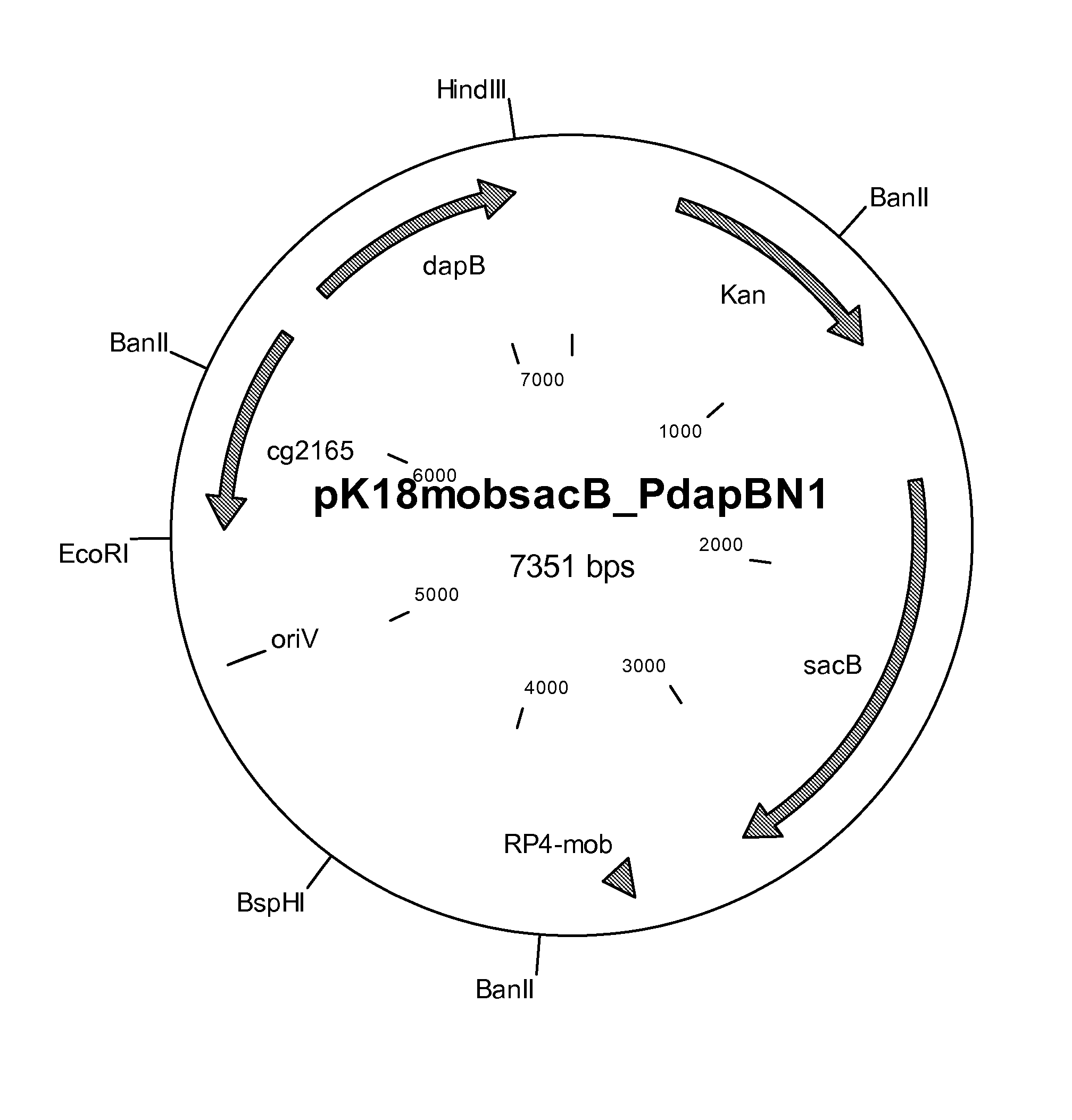Process for the production of L-lysine
a technology of lysine and lysine, which is applied in the field of process for the production of llysine, can solve the problems that the overexpression of dihydrodipicolinate reductase alone does not improve the secretion/excretion of l-lysine, and achieve the effect of improving the production of l-lysin
- Summary
- Abstract
- Description
- Claims
- Application Information
AI Technical Summary
Benefits of technology
Problems solved by technology
Method used
Image
Examples
example 1
Mutagenesis of the L-Lysine-Producing Strain DM1729
[0272]Corynebacterium glutamicum strain DM1729 was employed as the starting strain for mutagenesis with N-methyl-N′-nitro-N-nitrosoguanidine (MNNG). Strain DM1729 is an aminoethylcysteine-resistant mutant (pycP458S, homV59A, lysCT311I) of Corynebacterium glutamicum ATCC13032 (Georgi et al., Metabolic Engineering 7:291-301, 2005) and has been deposited on 16 Sep. 2005 at the Deutsche Sammlung far Mikroorganismen and Zellkulturen (DSMZ, Brunswick, Germany) under the name DSM17576.
[0273]Strain DM1729 was cultured in 10 ml of LB broth (Merck, Darmstadt, Germany), in a 100 ml Erlenmeyer flask for 24 hours at 33° C. and 200 rpm on a rotary shaker type Certomat BS-1 (B. Braun Biotech International, Melsungen, Germany). Thereafter, the culture was spun down, the sediment was resuspended in 10 ml of 0.9% strength NaCl solution, the suspension obtained was again spun down, and the sediment obtained was taken up in 10 ml 0.9% NaCl solution. 5 ...
example 2
Performance Test of the Mutants of Strain DM1729
[0274]The mutants obtained in Example 1 were grown in a nutrient medium which is suitable for the production of lysine, and the lysine content in the culture supernatant was determined.
[0275]To this end, the clones were first multiplied on brain-heart agar plates (Merck, Darmstadt, Germany) for 24 hours at 33° C. Starting from these agar plate cultures, in each case one preculture was inoculated (10 ml of medium in 100 ml Erlenmeyer flask). The preculture medium used was the MM medium. The preculture was incubated on a shaker for 24 hours at 33° C. and 240 rpm. This preculture was used to inoculate a main culture so that the initial OD (660 nm) of the main culture was 0.1 OD. The MM medium was also used for the main culture.
Medium MM
CSL 5 g / l
MOPS 20 g / l
Glucose (autoclaved separately) 50 g / l
Salts:
(NH4)2SO4) 25 g / l
KH2PO4 0.1 g / l
MgSO4*7 H2O 1.0 g / l
CaCl2*2 H2O 10 mg / l
FeSO4*7 H2O 10 mg / l
MnSO4*H2O 5.0 mg / l
Biotin (filter-sterilized) 0.3 mg / l
T...
example 3
Sequencing of the dapB Allele of the Mutant DM1729_Mut#3.2e
[0279]Chromosomal DNA was isolated from clone DM1729_mut#3.2e using the method of Eikmanns et al. (Microbiology 140: 1817-1828 (1994)). A DNA segment which carries the dapB gene, or allele, was amplified with the aid of the polymerase chain reaction. On the basis of the sequence of the dapB gene which is known for C. glutamicum (Accession No. NC—006958: 2051238-2051984 (complementary)) and the upstream and downstream regions, the following primer oligonucleotides were selected for the PCR:
[0280]PdapBN1—1.p (SEQ ID NO:7): 5′ CCGAATTCTGTAGTTGACGGCGTTCC 3′
[0281]PdapBN1—4.p (SEQ ID NO:8): 5′ CCAAGCTTCCACCCGCTGCTGAAATG 3′
[0282]The primers shown were synthesized by MWG Biotech (Ebersberg, Germany), and the PCR reaction was carried out by the standard PCR method of Innis et al. (PCR Protocols. A Guide to Methods and Applications, 1990, Academic Press). The primers allow the amplification of an approximately 1.69 kb DNA segment whic...
PUM
| Property | Measurement | Unit |
|---|---|---|
| Fraction | aaaaa | aaaaa |
| Fraction | aaaaa | aaaaa |
| Fraction | aaaaa | aaaaa |
Abstract
Description
Claims
Application Information
 Login to View More
Login to View More - R&D
- Intellectual Property
- Life Sciences
- Materials
- Tech Scout
- Unparalleled Data Quality
- Higher Quality Content
- 60% Fewer Hallucinations
Browse by: Latest US Patents, China's latest patents, Technical Efficacy Thesaurus, Application Domain, Technology Topic, Popular Technical Reports.
© 2025 PatSnap. All rights reserved.Legal|Privacy policy|Modern Slavery Act Transparency Statement|Sitemap|About US| Contact US: help@patsnap.com

